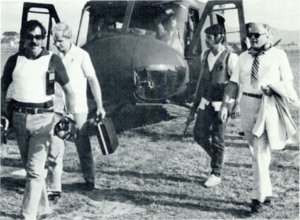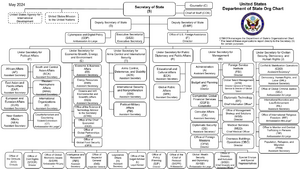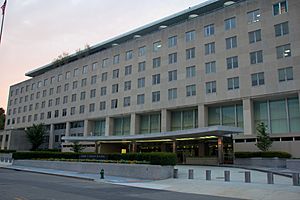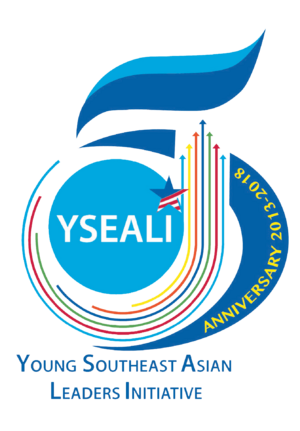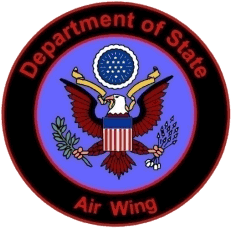United States Department of State facts for kids
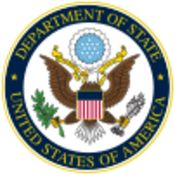
Seal of the Department of State
|
|
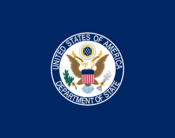
Flag of the Department of State
|
|
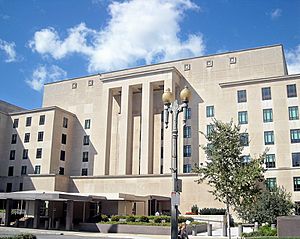 Department of State headquarters |
|
| Agency overview | |
|---|---|
| Formed | July 27, 1789 |
| Preceding agency |
|
| Type | Executive department |
| Jurisdiction | U.S. federal government |
| Headquarters | Harry S Truman Building, Northwest, Washington, D.C., U.S. 38°53′39″N 77°2′54″W / 38.89417°N 77.04833°W |
| Employees | 80,214 (total) 14,399 Foreign Service employees 12,831 Civil Service employees 50,703 local employees |
| Annual budget | USD 58 billion (FY 2025) |
| Agency executives |
|
The United States Department of State (often called the State Department) is a very important part of the U.S. federal government. Its main job is to handle the country's foreign policy and relationships with other nations. Think of it like the "foreign ministry" in other countries.
The State Department helps the U.S. president with international matters. It also runs U.S. embassies and consulates around the world. It helps create international agreements and protects American citizens who are living or traveling abroad. The department also represents the U.S. at the United Nations.
The main office is in the Harry S Truman Building in Washington, D.C.. This building is close to the White House. The State Department was started in 1789. It was the very first part of the U.S. government's executive branch.
The leader of the State Department is the U.S. secretary of state. This person works directly for the President and is a member of the President's Cabinet. The Secretary of State is the top diplomat for the U.S. and represents the country overseas. The current Secretary is Marco Rubio. He was chosen by President Donald Trump and approved by the U.S. Senate on January 20, 2025.
As of 2024, the State Department has 271 diplomatic offices worldwide. It also manages the U.S. Foreign Service. This is a group of people who work as diplomats and help with international relations. The department also helps with immigration and provides services to Americans. These services include issuing passports and visas. They also give travel advice and help American businesses abroad. The department has its own intelligence agency, the Bureau of Intelligence and Research (INR). It also has a law enforcement group called the Diplomatic Security Service (DSS).
Contents
- History of the State Department
- What the State Department Does
- How the State Department is Organized
- State Department Headquarters
- Programs and Initiatives
- Professional Fellows Program
- Fulbright Program
- National Security Language Initiative (NSLI-Y)
- Jefferson Science Fellows Program
- Franklin Fellows Program
- Young Southeast Asian Leaders Initiative (YSEALI)
- Young African Leaders Initiative (YALI)
- Kennedy-Lugar Youth Exchange and Study (KL-YES) Program
- Alumni TIES
- Diplomats in Residence
- Global Health Security Efforts
- Military Support for the State Department
- Spending and Finances
- Records and Information
- Images for kids
- See also
History of the State Department
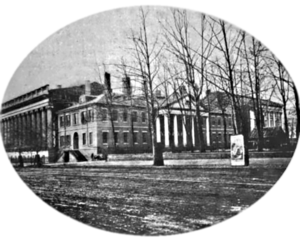
Early Beginnings
Before the U.S. Constitution, foreign affairs were handled by a group called the Committee of Secret Correspondence. This group was formed in 1775. It was later renamed the Committee of Foreign Affairs. In 1781, the Department of Foreign Affairs was created as a permanent office.
When the U.S. Constitution was written in 1787, it gave the President the job of dealing with other countries. So, on July 21, 1789, the first U.S. Congress decided to restart the Department of Foreign Affairs. President George Washington signed this into law on July 27, 1789. This made it the first federal agency under the new Constitution.
In September 1789, the agency's name was changed to the Department of State. It was also given some domestic duties, like managing the United States Mint and keeping the Great Seal of the United States. Most of these domestic jobs were later moved to other government departments. However, the Secretary of State still keeps the Great Seal. The Secretary also receives resignation letters from the President or Vice President.
Growth and Changes in the 1800s
In the 1800s, the State Department grew. It managed services for Americans abroad and helped with security. The department had two main parts: the diplomatic service and the consular service. The diplomatic service worked in embassies. The consular service helped American businesses and sailors overseas.
Over time, the department was reorganized several times. New offices were created to handle different tasks. For example, an office for patents was added in 1793. Later, a statistics office was created to report on foreign trade. In 1853, the job of Assistant Secretary of State was created to help oversee the different offices.
Modernizing in the 1900s
In 1909, the State Department received more funding. This allowed it to create new divisions. These divisions focused on different parts of the world, like Latin America and Europe. During World War I, the department became very important for checking people entering and leaving the U.S.
A big change happened in 1924 with the Rogers Act. This law combined the diplomatic and consular services into the United States Foreign Service. This made it a professional system where diplomats could be assigned anywhere in the world. A difficult exam was also started to make sure only highly qualified people joined.
After World War II, the U.S. became a superpower. The State Department grew a lot during the Cold War. The number of employees increased from about 2,000 in 1940 to over 13,000 in 1960.
In 1984, the Rewards for Justice Program was created. This program offers money for information that helps catch leaders of terrorist groups. In 1997, Madeleine Albright became the first woman to be Secretary of State. She was also the first foreign-born woman in the Cabinet.
The State Department Today
In the 2000s, the department adapted to the digital age. In 2007, it launched a blog called Dipnote and a Twitter account. It also created an internal wiki called Diplopedia. These tools help the department connect with people around the world.
From 2009 to 2017, the department used "21st Century Statecraft." This idea was about using digital tools and the Internet to achieve foreign policy goals. For example, they used text messages to help with disaster relief.
Colin Powell was the first African-American Secretary of State (2001-2005). His successor, Condoleezza Rice, was the second woman and second African-American to hold the job. Hillary Clinton became the third female Secretary of State in 2009.
In 2014, the State Department began expanding into the Navy Hill Complex. This new area is across the street from the Truman Building. In June 2022, the department started a new group called the Minerals Security Partnership.
What the State Department Does
The State Department is the main U.S. agency for foreign affairs. The Secretary of State is the President's top advisor on foreign policy. The department works to achieve U.S. goals and interests around the world. It also provides important services to U.S. citizens and to foreigners who want to visit or move to the United States.
The money for foreign affairs activities comes from a small part of the total federal budget. It is usually a little more than 1%.
The department's main jobs include:
- Protecting and helping U.S. citizens who live or travel abroad.
- Helping American businesses in the international market.
- Supporting international activities of other U.S. government agencies. This includes official visits overseas and diplomatic efforts.
- Keeping the public informed about U.S. foreign policy. They also get feedback from the public for government officials.
- Providing car registration for diplomats and their staff in the U.S.
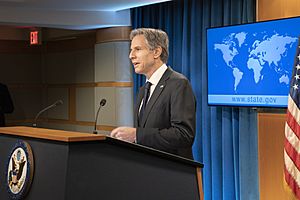
The State Department has a civilian workforce. Many employees are part of the Foreign Service. They are assigned to diplomatic missions abroad. Their jobs include representing the U.S., reporting on global trends, processing visas, and helping U.S. citizens.
The U.S. has diplomatic relations with about 180 countries. It also works with many international organizations. This adds up to 273 offices around the world. In the U.S., about 5,000 employees work to analyze reports, provide support, communicate with the public, and issue passports. The State Department works closely with other agencies like the Departments of Defense and Commerce. It also talks with Congress about foreign policy.
How the State Department is Organized
Leadership Structure
The most important person in the department is the Secretary of State. The Secretary leads the entire department and its staff. They report directly to the president of the United States.
Below the Secretary are the Deputy Secretary and the Deputy Secretary for Management and Resources. These are the second and third highest-ranking officials. Below them are six Under Secretaries. Each Under Secretary oversees several offices that handle specific policy areas. Most offices are led by an Assistant Secretary of State. Some leaders have other titles, like Director.
The President chooses officials from the Secretary down to the Assistant Secretaries. The Senate must approve these choices.
Staff
The State Department has many employees. This includes Foreign Service officers who work overseas. It also includes local staff who work in other countries. And there are Civil Service employees who mostly work in the U.S.
| United States State Department Organization (2025) | |
|---|---|
| Secretary of State | Chief of Staff |
| United States Mission to the United Nations | |
| Bureau of Intelligence and Research | |
| Bureau of Legislative Affairs | |
| Office of Global Women's Issues | |
| Office of the Legal Adviser | |
| Policy Planning Staff | |
| Counselor | |
| Executive Secretariat | |
| Office of Civil Rights | |
| Office of the Ombuds | |
| Office of the Chief of Protocol | |
| Special Envoys and Special Representatives | |
| Deputy Secretary of State | Bureau of Cyberspace and Digital Policy |
| Office of the Ambassador-at-Large for Arctic Affairs | |
| Deputy Secretary of State for Management and Resources |
Office of U.S. Foreign Assistance |
| Office of Small and Disadvantaged Business Utilization | |
| Under Secretary of State for Political Affairs |
Bureau of African Affairs |
| Bureau of Counterterrorism and Countering Violent Extremism | |
| Bureau of East Asian and Pacific Affairs | |
| Bureau of European and Eurasian Affairs | |
| Bureau of International Organization Affairs | |
| Bureau of Near Eastern Affairs | |
| Bureau of South and Central Asian Affairs | |
| Bureau of Western Hemisphere Affairs | |
| Under Secretary of State for Management |
Bureau of Administration |
| Bureau of Budget and Planning | |
| Bureau of Consular Affairs *Office of Children's Issues |
|
| Bureau of Diplomatic Security *U.S. Diplomatic Security Service (DSS) |
|
| Office of Foreign Missions | |
| Bureau of Global Talent Management | |
| United States Foreign Service | |
| Bureau of Diplomatic Technology | |
| Bureau of Medical Services | |
| Bureau of Overseas Buildings Operations | |
| Director of Diplomatic Reception Rooms | |
| Foreign Service Institute | |
| Office of Management Strategy and Solutions | |
| Under Secretary of State for Economic Growth, Energy, and the Environment |
Bureau of Economic and Business Affairs |
| Bureau of Energy Resources | |
| Bureau of Oceans and International Environmental and Scientific Affairs | |
| Office of Global Food Security | |
| Office of Global Partnerships | |
| Office of the Science and Technology Adviser | |
| Office of the Chief Economist | |
| Under Secretary of State for Public Diplomacy and Public Affairs |
Bureau of Educational and Cultural Affairs *Internet Access and Training Program |
| Bureau of Public Affairs *Spokesperson for the United States Department of State *Office of the Historian *United States Diplomacy Center |
|
| Bureau of International Information Programs | |
| Office of Policy, Planning, and Resources for Public Diplomacy and Public Affairs | |
| Under Secretary of State for Arms Control and International Security Affairs |
Bureau of International Security and Nonproliferation |
| Bureau of Political-Military Affairs | |
| Bureau of Arms Control, Verification, and Compliance | |
| Bureau for International Narcotics and Law Enforcement Affairs | |
| Under Secretary of State for Foreign Assistance, Humanitarian Affairs and Religious Freedom | Bureau of Conflict and Stabilization Operations |
| *Office of the Coordinator for Reconstruction and Stabilization | |
| Bureau of Democracy, Human Rights, and Labor | |
| Bureau of Population, Refugees, and Migration | |
| Bureau of Global Health Security and Diplomacy | |
| Office of Global Criminal Justice | |
| Office of International Religious Freedom | |
| Office to Monitor and Combat Trafficking in Persons | |
Other Agencies Working with State
The Administrator of the U.S. Agency for International Development (USAID) also reports to the Secretary of State. USAID is an independent agency that provides foreign aid. The U.S. ambassador to the United Nations also reports to the Secretary of State.
State Department Headquarters
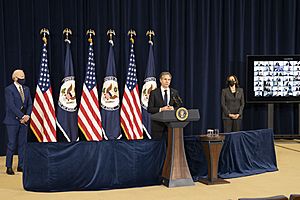
From 1790 to 1800, the State Department was in Philadelphia. This was the U.S. capital at the time. In 1800, it moved to Washington, D.C. It moved to several different buildings over the years.
Since May 1947, the State Department has been in the Harry S. Truman Building. This building was originally meant for the Department of Defense. It has been expanded and updated many times. In September 2000, it was named after President Harry S. Truman. He strongly supported international cooperation.
Because the department is in the Foggy Bottom neighborhood of Washington, D.C., people sometimes call it "Foggy Bottom."
Programs and Initiatives
Professional Fellows Program
The State Department has a Professional Exchange Fellows program. It chooses professionals from around the world. These fellows spend time in the United States. They interact with American colleagues and leaders.
Fulbright Program

The Fulbright Program offers grants for international educational exchange. It helps students, scholars, teachers, and artists. U.S. citizens can get scholarships to study or research abroad. Citizens of other countries can do the same in the United States. The program started in 1946. Its goal is to help people from different countries understand each other better.
The Fulbright Program gives out 8,000 grants each year. These grants are for graduate study, research, and teaching. The Bureau of Educational and Cultural Affairs at the State Department sponsors the program. It gets money from the U.S. Congress. Many countries, foundations, and companies also support it. The program works in over 160 countries. More than 360,000 people have participated. Many Fulbright alumni have won Nobel Prizes and Pulitzer Prizes.
National Security Language Initiative (NSLI-Y)
The NSLI-Y is a scholarship program. It helps American high school students learn important foreign languages. These languages include Korean, Mandarin, Russian, and Arabic. Students can study these languages in summer or year-long programs abroad.
Jefferson Science Fellows Program
This program started in 2003. It brings American scientists, engineers, and doctors to work with the State Department. They help the department with U.S. foreign policy. Fellows learn about how the department works. They also help with its daily operations.
Franklin Fellows Program
The Franklin Fellows Program began in 2006. It brings experienced professionals from businesses and non-profit groups. They advise the department and work on projects. Fellows can also work with other government groups. The program is named after Benjamin Franklin. It aims to bring new ideas and skills to the department.
Young Southeast Asian Leaders Initiative (YSEALI)
The Young Southeast Asian Leaders Initiative (YSEALI) is for young leaders from Southeast Asia. President Barack Obama launched it in 2013. It helps young people aged 18 to 35 develop leadership skills. It also helps them network and learn about different cultures.
YSEALI offers exchange programs to the United States. It also holds workshops in Southeast Asia. The programs focus on topics like civic engagement, sustainable development, and the environment.
Young African Leaders Initiative (YALI)
The Young African Leaders Initiative (YALI) is for young leaders in Africa. President Barack Obama started it in 2010. It promotes education and networking for young African leaders. The Mandela Washington Fellowship brings them to study in the U.S. for six weeks. The program also has leadership centers in Ghana, Kenya, Senegal, and South Africa.
Kennedy-Lugar Youth Exchange and Study (KL-YES) Program
The Kennedy-Lugar Youth Exchange and Study (KL-YES) program started in 2002. It helps high school students from countries with large Muslim populations study in the United States. This helps build cultural understanding. The program includes coursework, cultural activities, and community service. The YES Abroad program allows American students to study abroad in these countries.
Alumni TIES
Alumni TIES stands for Alumni Thematic International Exchange Seminars. These seminars are for people who have participated in U.S. government exchange programs. Alumni learn about important regional issues. They also get training and can apply for small grants to start projects in their home communities.
Diplomats in Residence
Diplomats in Residence are experienced Foreign Service officers. They are located across the U.S. They give advice about careers, internships, and fellowships. They help students and professionals in their communities learn about working for the State Department.
Global Health Security Efforts
The State Department supports global health through its Bureau of Global Health Security and Diplomacy. This bureau manages programs like the President's Emergency Plan for AIDS Relief. This program aims to help end the HIV/AIDS pandemic by 2030. The department also works to improve global health communication and response.
Military Support for the State Department
Department of State Air Wing
The Bureau for International Narcotics and Law Enforcement Affairs (INL) formed an office in 1978. It used aircraft to help other countries with anti-drug operations. The Air Wing was officially created in 1986.
After the September 11 attacks, the Air Wing expanded its work. It started providing security support for U.S. citizens and interests. This was mainly in Afghanistan and Pakistan. They transport diplomatic teams safely. They use larger aircraft like the Sikorsky S-61 and Boeing Vertol CH-46. In 2011, the Air Wing had over 230 aircraft worldwide.
In 1964, U.S. Navy Seabees were assigned to the State Department. This happened after listening devices were found in the U.S. Embassy in Moscow. This led to the creation of the Naval Support Unit in 1966.
These Seabees are assigned to Diplomatic Security. They install alarm systems, CCTV cameras, and other security features. They also help with new construction or renovations in sensitive areas. They often wear civilian clothes due to diplomatic rules.
Army Reserve Counter Terrorism Unit
The Army Reserve Counter Terrorism Unit (ARCTU) is part of the Army Reserve. It is funded by the Military Intelligence Readiness Command. It works under the Bureau of Counterterrorism. This unit also helps the Diplomatic Security's Foreign Emergency Support Team. This team responds to global crises quickly. Like other military groups helping the State Department, they often wear civilian clothes.
Spending and Finances
In 2010, the State Department and other international programs had a budget of $51.7 billion. The actual costs for the year were $27.4 billion. The department earned $6.0 billion from services like passports and visas. This reduced the total cost to $21.4 billion.
The department's spending includes money for peace and security, promoting democracy, investing in people, and humanitarian aid. It also spends on promoting international understanding and strengthening its own operations.
Records and Information
Since 1973, the main record-keeping system is the Central Foreign Policy File. It contains copies of official telegrams, reports, and other documents about foreign relations. Over 1,000,000 records from 1973 to 1979 can be found online. They are kept by the National Archives and Records Administration.
Images for kids
-
Secretary of State Antony Blinken with President Joe Biden and Vice President Kamala Harris at the State Department headquarters in February 2021.
See also
 In Spanish: Departamento de Estado de los Estados Unidos para niños
In Spanish: Departamento de Estado de los Estados Unidos para niños


